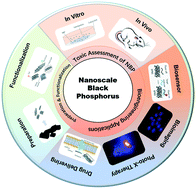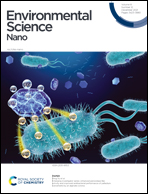Bioengineering applications of black phosphorus and their toxicity assessment
Abstract
During the last decade, 2-dimensional nanoscale black phosphorus (NBP) has been actively used for biomedical research and applications. NBP possesses unique properties such as an adjustable direct band gap, high near-infrared (NIR) photothermal conversion efficiency, large surface area for versatile surface chemistry functionalization and good biodegradability for in vivo delivery and therapy. Many groups have reported that functionalized NBP can be applied for biomedical applications. However, untreated NBP is unstable and if it is applied biologically, it might trigger harmful nano-bio interactions and cause adverse effects on the biological system permanently. In this review, we summarized the bioengineering applications of NBP, including biosensing, photoimaging, photo-X therapy and drug delivery. Then, the various nano–bio interactions that occurred during the use of NBP for bioengineering research with an emphasis on examining the adverse impacts of NBP on the integrity of the cell membrane structure were analyzed. The in vivo instability of NBP inducing phagocytosis, increasing the levels of many kinds of cytokines in the blood, and resulting in various responses to the body was discussed systematically. Based on our analysis, the in vitro and in vivo toxicity of NBP can be reduced by strategically functionalizing its surface with biocompatible materials such as hydrogels, polymers and fibrin.



 Please wait while we load your content...
Please wait while we load your content...